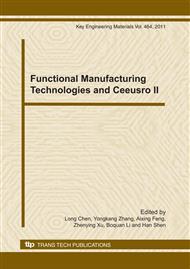p.191
p.195
p.199
p.204
p.208
p.213
p.217
p.221
p.225
FEM Simulation of a Twin-Island Structure Chip in Piezoresistive Pressure Sensor
Abstract:
In this paper a twin-island structure in piezoresistive pressure sensor based on MEMS technology has been presented, and a finite element mechanical model has been developed to simulate the static mechanical behavior of this twin-island structure sensor chip, especially the stress distributions in diaphragm of the sensor chip, which has a vital significance on piezoresistive pressure sensors’ sensitivity. The possible impacts of twin-island’s location and twin-island’s width on the stress distributions, as well as the maximum value of compressive stress and tensile stress, have been investigated based on numerical simulation with Finite Element Method (FEM). The simulation results show that twin-island’s location has great effect on the stress distributions in sensor chips’ diaphragms and the sensitivity of piezoresistive pressure sensors, compared with the twin-island’s width.
Info:
Periodical:
Pages:
208-212
Citation:
Online since:
January 2011
Authors:
Price:
Сopyright:
© 2011 Trans Tech Publications Ltd. All Rights Reserved
Share:
Citation:


